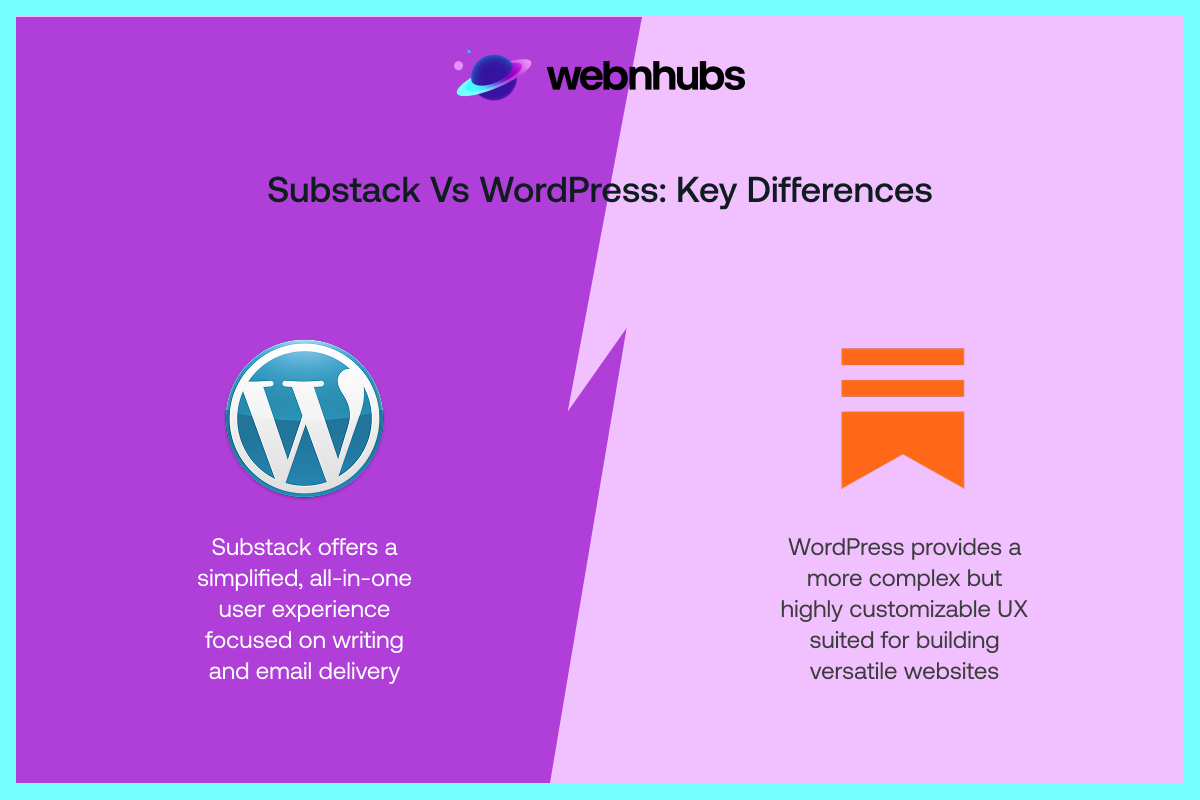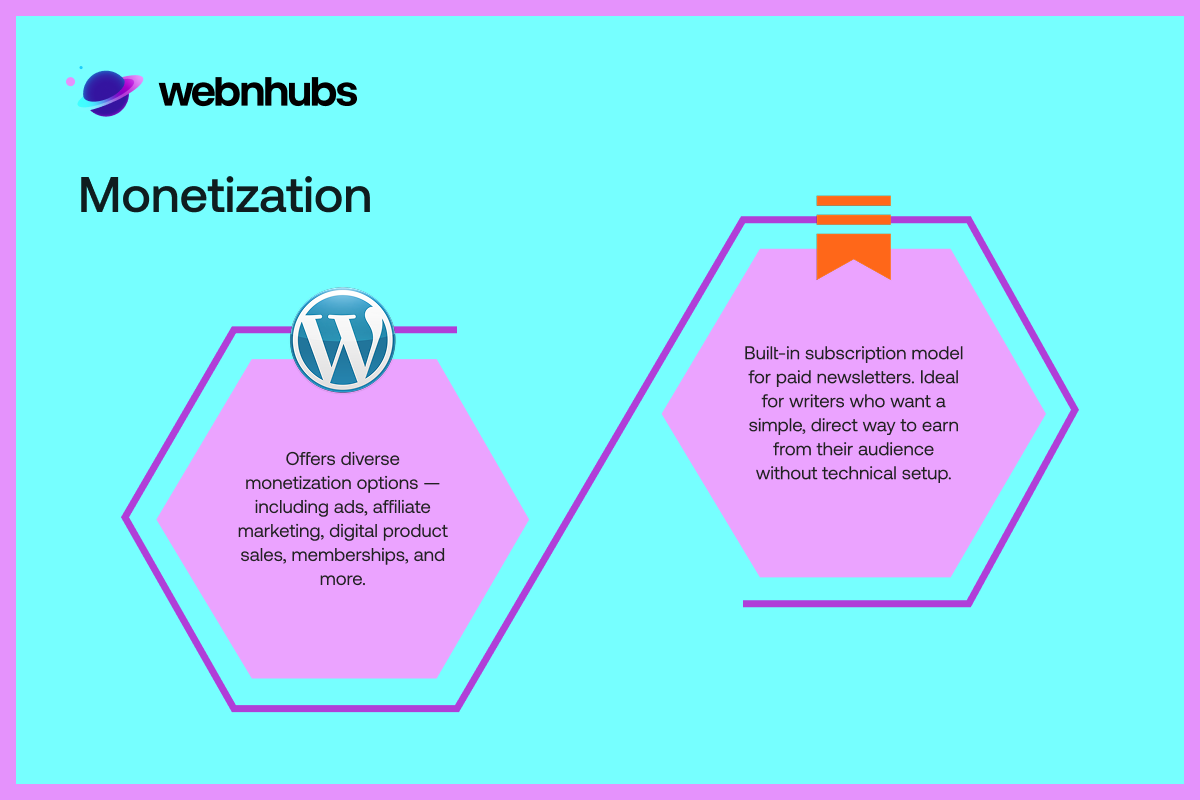
- Substack vs WordPress: Key Differences
- User Interface
- Customization Options
- The Creation of Content
- How Often Should You Maintain Your Website?
- Substack vs WordPress: APE Features
- Design Flexibility
- SEO Capabilities
- Monetization
- Sustainability for Evolving Companies
- Which of the Two is More Economical?
- Security
- Ease of Use
- Mobile Responsiveness
- Blog Writing
- Substack vs WordPress: E-commerce Capabilities
- Website Maintenance: Can Substack beat WordPress?
Substack vs WordPress: Key Differences

As we know, Substack vs WordPress is a common controversy that people face while establishing a web presence for themselves. Substack is relatively simple; it provides users with the proper tools for creating an email newsletter and posting content. On the other hand, WordPress is a robust CMS, with millions of users across the world. They use it to create a wide range of websites, ranging from blogs to online shops. For what’s it worth, which site provides the best interface for the users? In this blog post, we will explore Substack and WordPress’s functionality, versatility, and ease of use. This is to give you a detailed comparison that boils down to the platform you must focus on. If you are a blogger, businessperson, or content provider, this comparison can help you focus on your objectives.
User Interface
Arguably, one of the most important components of users’ experience is the interface or the front end. Comparing Substack to WordPress, the audience can identify that Substack favors simplicity over functionality. Compared to other similar software, its interface is simple and uncluttered. This enables the users to begin creating and distributing newsletters on the spot. WordPress, on the other hand, presents a more elaborate working platform to the user. Despite this, there is a trade-off. Flexibility and freedom come at the cost of being more complex, which requires time to get used to. In terms of ease of use, Substack wins this comparison. Its interface is user-friendly and accessible, especially for new users. But for individuals who need more features beyond the basic ones that Substack offers, WordPress will be more appropriate.
Customization Options

Another feature that determines whether someone would prefer Substack over WordPress or vice versa is customization. This is where WordPress stands tall with thousands of themes, plugins, and choices in design. WordPress can help you to design highly functional and unique sites. Regardless of whether you hire the services or develop the site on your own, the options are almost boundless. Substack, on the other hand, allows very little of customization or personalization as far as the blog is concerned. While users can make slight changes to the design of the page and posts, the focus is more on content. So, for creators who want to have more control over aesthetics and branding, WordPress provides so much more than Substack.
The Creation of Content
The process of creating content is another key factor that one needs to bear in mind. Substack is about writing and sending newsletters; it is easy to use for those who want to share content. Another advantage of Newsletter is its built-in email distribution system, which can help newsletter writers a lot. WordPress, on the other hand, provides users with a rich content creation toolset. Apart from blogging, it also supports the management of multimedia, landing pages, and even sophisticated websites. For creating multimedia-rich posts or developing a digital landing page, WordPress offers more features and customization options. For writers who are more focused on text-based content and newsletters, Substack has the advantage of a clean and simple interface.
How Often Should You Maintain Your Website?
The frequency of site maintenance may vary due to the size and complexity of the website and its purpose. If a website belongs to a small business or a person has a blog, they may perform the checklist once a month. Yet, for larger websites or even online shops where a high number of transactions and user interactions happen daily, weekly or even daily checks are necessary. This avoids any downtimes and guarantees a seamless user experience. Aside from these frequent updates, it is beneficial to make quarterly or bi-annual audits to assess the general performance, usability, and security of the site. Performing an audit helps to evaluate if the website meets modern trends, hardware and software developments, and legal requirements. Technicians claim that frequently performing website maintenance not only helps address critical problems but also enhances customer satisfaction.
Substack vs WordPress: APE Features
Website maintenance is indeed an extremely important task when it comes to enhancing the overall SEO experience. Websites with a good user experience, less loading time, and stronger security measures favor search engines such as Google. Not keeping up with these elements can negatively affect your site’s search engine rankings. Poor quality content, ineffective link structure, and slow loading time will give a negative signal to the search engines. It is better to change the content periodically, refine keywords, update the meta description, and work on the speed of your site. This enables search engines to crawl easily. Another important aspect of SEO is having a mobile-friendly and responsive site. This is because many users are accessing the web through mobile devices. Having a site that is optimized for mobile use is a plus. It helps you rank well, especially if you have a responsive design. Furthermore, resolving technical SEO issues like 404 errors or redirect issues makes sure that search engines can correctly crawl through your site.
Design Flexibility
Flexibility in designing is where Substack and WordPress are worlds apart. There is no better CMS platform in terms of design flexibility since WordPress has thousands of themes. It allows you to adjust every aspect of a website’s design. Whether you involve a WordPress development company or employ drag-and-drop builders, WordPress lets you build an incredibly customized website. Substack, on the other hand, presents much more limitations in terms of design. It is primarily an outlet for content distribution, as it lacks most of the aspects of design. This lack of flexibility can sometimes be a disadvantage for users who may desire to brand themselves or their sites in a far more unique manner.
SEO Capabilities

Forcing A/B comparisons in the context of SEO is an important aspect of content exposure, and here, Substack vs WordPress reveals the winner. WordPress supports various SEO plugins, including Yoast, and All-in-One SEO, among others, enabling users to optimize for search engines effortlessly. These tools give an analysis of keywords, meta tag descriptions, and any technical issues regarding SEO. That is why Substack in particular still has not very powerful SEO tools at its disposal. While Substack’s newsletters can pull traffic, it doesn’t allow for the same kind of fine-tuning of SEO settings as WordPress. And for content creators who want to optimize their websites for search engines, WordPress is still better off.
Monetization

Even though both Substack and WordPress do provide ways for monetization, the two platforms do it in rather different ways. In the case of Substack vs WordPress, Substack has incorporated the subscription model that enables content creators to directly monetize their audience. It makes it appealing to writers who wish to turn their newsletters into a revenue-generating activity. Yet, WordPress has multiple additional ways of generating income as compared to Wix, including selling digital goods and memberships, advertising, and affiliate marketing. With WordPress or other e-commerce plugins at their disposal, users can build complex revenue models. In a bid to make extra income, WordPress is more resourceful to the creators compared to Substack.
Sustainability for Evolving Companies
Another critical aspect that can influence the choice for a growing business is scalability; in this comparison, WordPress seems to be a more scalable platform. Indeed, WordPress is flexible enough to support websites of any kind, starting from the small blog to the big e-commerce store. Due to the availability of plugin extensions, customizations, and integrations, the tool enables businesses to scale as they wish. For example, WordPress can develop a basic blog into a complete digital business with online sales functions, custom advancements, progressed measurements, and selling convenience.
Substack, as wonderful for individual authors, isn’t as versatile. While it is mainly tailored for email newsletters and is easy to use, it lacks the functionality to accommodate large complex sites or companies that need to employ several services. In this aspect, WordPress has been proven to be more scalable in terms of features for companies that are looking for future expansion or need a broad range of facilities and services. Engaging a WordPress development company can help extend this growth process by making sure the website’s foundation is ready for growth and change.
Which of the Two is More Economical?
In the Substack vs WordPress battle, affordability varies depending on the needs of the user, as described above. Substack is based on the freemium business model, it is free, while the platform owner has a right to get 10% from a paid subscription. This makes it an affordable platform for bloggers who would like to monetize their content through subscriptions, given that there are no initial costs. However, creators with thousands of dollars in monthly revenues may see that 10% cut eat up a portion of their potential earnings.
WordPress is free to use, but there are costs required for hosting premium themes, and plugins. Perhaps professional assistance from a business WordPress development company also adds to website design costs. These costs are different depending on the necessary equipment and tools, but they provide accurate control of financial expenses. This means that while a user can easily find affordable solutions, it is also possible to find premium options. Options that can fit the needs of a user with a higher budget as well. It is particularly suitable for businesses that need more features or absolute control of website design costs. WordPress could ultimately be cheaper for big business than Substack’s commission model.
Security
Another major factor to consider while choosing between Substack and WordPress for the blog is the aspect of security. Since WordPress is open source, it has flexibility of its own, but then the security part is partially dependent on the user. Maintaining updates, selecting suitable plugins, and hosting platforms are other crucial factors in avoiding vulnerabilities in WordPress sites. Engaging the services of a WordPress development company can improve this process and make sure that the website is safe from any threats.
On the other hand, Substack considers security for its users, but it is not something that the users interact with directly. Since it is an enclosed environment, it controls updates, and security patches, and protects against hacking, thus freeing the users from this task. Substack, on the other hand, offers content creators who do not wish to deal with the process of protection, a more convenient online platform. Nevertheless, if one wants to have complete control over the security measures of the site, WordPress is a better platform to choose from as it allows more variants in protecting the information.
Ease of Use

As seen in the Substack vs WordPress ease of use comparison, both platforms are designed to serve specific users. The initial appeal of Substack is its low-frills offering. Through its interface, the platform makes it easy for writers and creators to get started and launch newsletters. This too without focusing on the technicalities of the process. Its simplicity makes it a preferred option for users who are only interested in creating content and not site design.
WordPress provides a wider set of options and opportunities, as well as more options for customization. When it comes to creating a WordPress site that has some specific features, this process can take more time. For anyone who wants to create a website that has more flexibility, options, and functionality, WordPress’s steep learning curve is something to be endured. By working with a WordPress development company, even beginners can navigate the platform more easily. If we look at the comparison from the perspective of the layman who isn’t well-versed in web development, Substack indeed has the upper hand. But for a user who is willing to make investments of time and energy, WordPress offers so much more.
Mobile Responsiveness
Mobile responsiveness is critical in today’s digital landscape, and in the Substack vs WordPress debate, both platforms offer mobile-friendly experiences, but WordPress excels in customization. WordPress provides a wide variety of responsive themes and plugins, allowing users to create a fully optimized, mobile-friendly site. This is essential as more users’ access content via smartphones and tablets. The ability to customize a digital landing page specifically for mobile visitors is a major advantage that WordPress offers.
Substack, while responsive by default, lacks the same level of control. The platform automatically adjusts to mobile devices, but creators have little influence over how their content appears on smaller screens. For those who need a fully customizable mobile experience, especially for businesses looking to convert mobile traffic, WordPress offers far more options and tools to ensure a seamless experience. Mobile optimization is crucial, and WordPress provides the flexibility needed to meet this demand effectively.
Blog Writing
While comparing Substack vs WordPress, it is crucial to understand that the offered platforms provide tailored solutions for writers with different goals and objectives. Substack is primarily an email-first publishing platform with a minimal interface designed especially for newsletters. It’s particularly suitable for authors who would like to establish first-hand communication with their audience through email. It also simplifies content creation, dissemination, and sales through subscriptions, thus making it a platform ideal for independent creators.
WordPress is an established content management system for handling more versatile blogs with different media formats, built-in SEO features, and comment moderation tools. For this reason, it will work best for regular blogging, essay writing, or blogs that contain many images or videos. WordPress can be connected to other tools, which makes the overall blogging experience more powerful. If one is looking for a kind of page that exercises more control over designs, search engine visibility, and interaction with the reader, then WordPress is a more appropriate platform for blogging. Substack is beneficial for email-first strategies, but WordPress offers a flexible solution for various blogging requirements.
Substack vs WordPress: E-commerce Capabilities
It is evident that there are many differences between Substack and WordPress when it comes to e-commerce. Substack is mostly a content-first platform with some degree of the functionality of an e-commerce platform. It is useful for creators who wish to use paid subscriptions, but there are no appropriate tools for selling tangible and digital goods. This limitation frustrates its use, especially for people who are in business or anyone who wants to start a strong online store.
However, WordPress stands out in the e-commerce niche. WooCommerce is an electronic business plugin through which WordPress users can create an efficient online store inclusive of inventory control, payment options, and product information. Being able to sell anything from tangible goods to downloadable items, or even services, WordPress has all the necessary needs for a strong e-commerce operation. If someone is interested in making money through the sale of products, services, or advertising, then WordPress is ideal. While Substack is perfect for subscription-based business models, WordPress will suit many varieties of e-commerce businesses well due to its flexibility.
Website Maintenance: Can Substack beat WordPress?
Website maintenance is one of the key areas that affect the overall comparison between Substack and WordPress. Substack is a closed platform, which eliminates user concerns such as updates, security patches, and technical software maintenance. This model is especially suitable for artists who don’t want to deal with any web development issues and would simply like to focus on content creation. Another advantage of Substack is that it does not require substantial time and effort to maintain, thus, being low-maintenance.
WordPress, on the other hand, needs constant care and maintenance from the users, which entails updates, security checks, and backups. Users may also need to track the updates of the plugins as well as the compatibility of the themes. Thus, it gives the users better control over their website; however, it does so at the cost of being more time-consuming and requiring some technical background. Hiring a WordPress development company to perform maintenance work can help avoid these issues and make sure that the site operates reliably and is protected against cyber threats. WordPress is more flexible, but compared to Substack, it will also need more time and effort in maintenance.
Final Verdict: Substack vs WordPress: Which is the better platform?

In conclusion, the winner of the Substack vs WordPress fight depends on what you want and need from your blogging platform. For a writer or content creator who wants to create nothing but an email newsletter, Substack is a one-stop platform due to its simplicity and built-in tools for making money. It helps you to concentrate on creating blogs without straining yourself with other technical aspects of website development. But for businesses or individuals who need more customization, flexibility, and scalability, WordPress is a better option. It may be used to create websites on various topics, online stores, plugins, and even marketing solutions. In general, WordPress has the potential to support blogs, personal websites, and even business-oriented web resources. This versatility makes the platform suitable for building sustainable growth strategies for the long term. If you cannot determine which option will be the most helpful depending on your particular focus, it may be helpful to speak with a WordPress development company. Finally, WordPress is a better platform for users who want more control and customization options.
Frequently Asked Questions
Substack is the simplest to use as it offers writers a platform that provides newsletters and monetization capabilities. WordPress, in its turn, provides complete control over the design, SEO, and scalability, which is optimal in case a business or a brand is going out of written content only.
Migration is not always easy. You can lose format, pictures or subscriber records, so you should plan redirects, export backup and be prepared to recreate some of the functions manually through the transition.
Substack takes a 10% fee on subscriptions (paid) whereas with WordPress, there are initial hosting and plugin fees. Eventually, WordPress will tend to be cheaper and more profitable because you own your own revenue and payment systems.
WordPress offers complete access to SEO tools, custom domains and freedom to design, giving you complete control over the brand. The in-built network provided by Substack is useful in discovery, but has little customization of the SEO and limited visual identity.
Well, it depends on your needs and requirement. Also, how much can you expand and invest. For examples, if you need a customized e-commerce store, use a WordPress platform. It provides you with endless plugins and serves the need for membership and online courses. If you are dealing with subscription, content distribution or newsletter, go for Substack.
